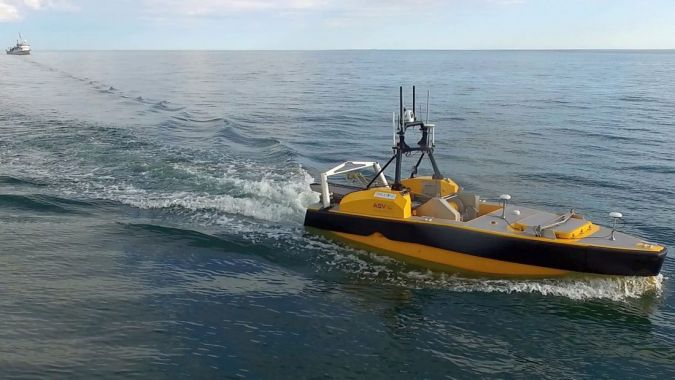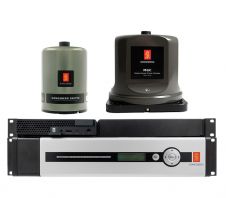Unmanned Surface Vehicle Trends and Insights
A Geomares Data Analysis
Advances in unmanned surface vehicle (USV) technology and increased demand are expected to drive the USV market over the coming years. Geomares, the publisher of Hydro International and Geo-matching, has analysed the user data and behaviour of thousands of members of the global hydrographic community. This article presents the findings of the analysis, identifying the latest trends and sharing insights on the outlook for USVs.
USVs combine the advantages of small survey vessels with those of unmanned survey platforms, giving them a range of applications varying from maritime security, protection of shallow waters and ports and ocean mapping [1]. Interesting applications include underwater topographic surveys in Antarctica [2] and long-term environmental monitoring for the Ocean Cleanup project [3].
Worldwide Growth in the USV Market
Market research shows that the USV market will grow significantly over the coming years, with North America being the sector leader. This is an exciting market forecast for USV manufacturers and it would be interesting to see if the website user behaviour for Hydro International and Geo-matching supports these findings.
The worldwide growing demand for USVs is related to a range of applications, such as ocean data and mapping, maritime security and protection of shallow waters and ports. When we zoom in on North America, it becomes clear that that the defence segment is the most important pillar of the unmanned surface vehicle market, with a strong focus on the autonomy and intelligence of USVs. In addition to the fact that North America is leading the global market, the USA is considered to be the largest developer, operator and exporter of USVs.

The European market shows significant growth as well, however, the applications that drive this increasing demand differ from the situation in North America. Scientific research and hydrographic surveying companies are employing USVs on a larger scale, however, there is a trend towards an increasing demand for maritime security in the European waters as well. The EU policy aims to achieve adequate maritime security to maintain the rule of law in areas beyond national jurisdiction and protect the EU strategic maritime interests. This encompasses new chances for manufacturers of USVs. The same can be said for other parts of the world with a strong interest in more secure seas and oceans, for example China.
Behaviour of Geo-matching Users
400,000 professionals visited the Hydro International and Geo-matching websites in 2018, and a large percentage of those visitors were interested in unmanned surface vehicles. This puts Geomares in a unique position to analyse website behaviour to discover trends and insights related to unmanned surface vehicles. To provide a balanced overview, this analysis is based on a combination of Geo-matching website data, Google search statistics and market research.
Data from the Geo-matching website shows a strong growth in interest in unmanned surface vehicles. Geo-matching is the world’s largest product platform for surveying, positioning and machine guidance, listing more than 2,000 products from 500 manufacturers and attracting more than 250,000 users in 2018. Unmanned surface systems technology is one of Geo-matching’s most important sections, featuring 38 products from 20 manufacturers. In 2018, the number of page views on the unmanned surface vehicles page has more than doubled (see Figure 1).
Google Search Volume
Google keyword planner was used to study the search volume for USVs worldwide (see Figure 2) from 2015-2018. Google statistics show a strong increase in search volume for unmanned surface vehicles. The searches for USVs grew from 2,064 average searches per month in 2015 to 3,250 average searches per month in 2018 – a growth of 64% in 3 years. October 2018 was an absolute record with 3,798 searches.
These figures include searches for unmanned surface vehicles and related search terms such as unmanned surface vessel, unmanned survey boat, autonomous surface vehicles, unmanned maritime vehicles and so on, but do not include specific product names.

Geo-matching Profile of Typical Unmanned Surface Vehicle Users
User surveys shows that Geo-matching is primarily used as an information source and is important for product research. Product specifications can be compared on Geo-matching, and users can read case studies/watch product videos and can contact product manufacturers directly.
The user behaviour provides interesting quantitative information and can show general trends, but the types of contact requests made through Geo-matching provides great insights into how, and for what purposes, unmanned surface vehicles are used. Geo-matching has seen inquiries ranging from major organisations like national armies to Hydrographic Offices and hydrographic surveying companies worldwide. Enquiries have also come from universities across the world (oceanographic research), fire brigades (search and rescue), port authorities (port surveys) and naval organisations worldwide.

The Geo-matching user profile is in line with market research stating that rising demand comes primarily from hydrographic and oceanographic organisations, but that there is also a strong need from the defence and security sector and to monitor water quality.
Regional Distribution
Market research identifies North America as the dominating region in the market for unmanned surface vehicles, followed by Asia-Pacific and Europe. It is interesting to see that the Geo-matching user profile is a bit different. The largest group is from the Asia-Pacific region (37%), followed by Europe (27%) and the Americas (26%). The strong presence of Asia-Pacific users on Geo-matching could mean that a lot of users from this region are investigating unmanned surface vehicle technology, making it a strong indicator for a growing market share in 2019.
Payloads for Unmanned Surface Vehicles
The growing unmanned surface vehicles market is also driving the growth for payloads enhancing USV capabilities. It is possible to equip USVs with cameras, sensors, sonars, X-band marine radars, visual systems, Lidar, echo sounders, and other payloads. Sensor payloads can be used to examine undersea cables and to classify a wide variety of chemicals in seawater and various other purposes.

Growing Demand for USVs in Asia
The growth in Asia-Pacific is expected to be primarily boosted by geo-political developments. China is establishing itself as a major power, investing in state of the art military and naval assets, thereby driving the unmanned systems market. Recently, countries such as Japan and India are also putting efforts into USVs and related technology. In the Asia-Pacific region, the application of USVs is also used to protect maritime assets, including economic zones, maritime borders and territorial waters, but also for oil rigs and deep-sea mining activities. Obviously, these applications are not only limited to this part of the world.
Conclusion
Geo-matching website data, Google search statistics and market research all clearly show that the demand for USV technology has increased over recent years. Hydrographic and oceanographic research will further drive the rising demand for USVs, but there is also a strong need from the defence and security sector and to monitor water quality. The unmanned surface vehicles market is expected to grow by 13.8% from 2018 to 2023, reaching a total market size of US$1 billion by 2023.

Market research shows that North America will be the dominating region in the market for unmanned surface vehicles, but Geo-matching user data shows that there is a strong interest in unmanned surface technology in the Asia-Pacific region. Geo-matching is primarily used for product research, so the increased interest in the Asia-Pacific region could be a strong indicator for a growing market in the Asia-Pacific region over the coming years.
This article is based on various sources to provide general trends and insights related to unmanned surface vehicles. For more research data and/or a personalised report, please contact Sybout Wijma ([email protected]).

Value staying current with hydrography?
Stay on the map with our expertly curated newsletters.
We provide educational insights, industry updates, and inspiring stories from the world of hydrography to help you learn, grow, and navigate your field with confidence. Don't miss out - subscribe today and ensure you're always informed, educated, and inspired by the latest in hydrographic technology and research.
Choose your newsletter(s)
























